PLC Market Size
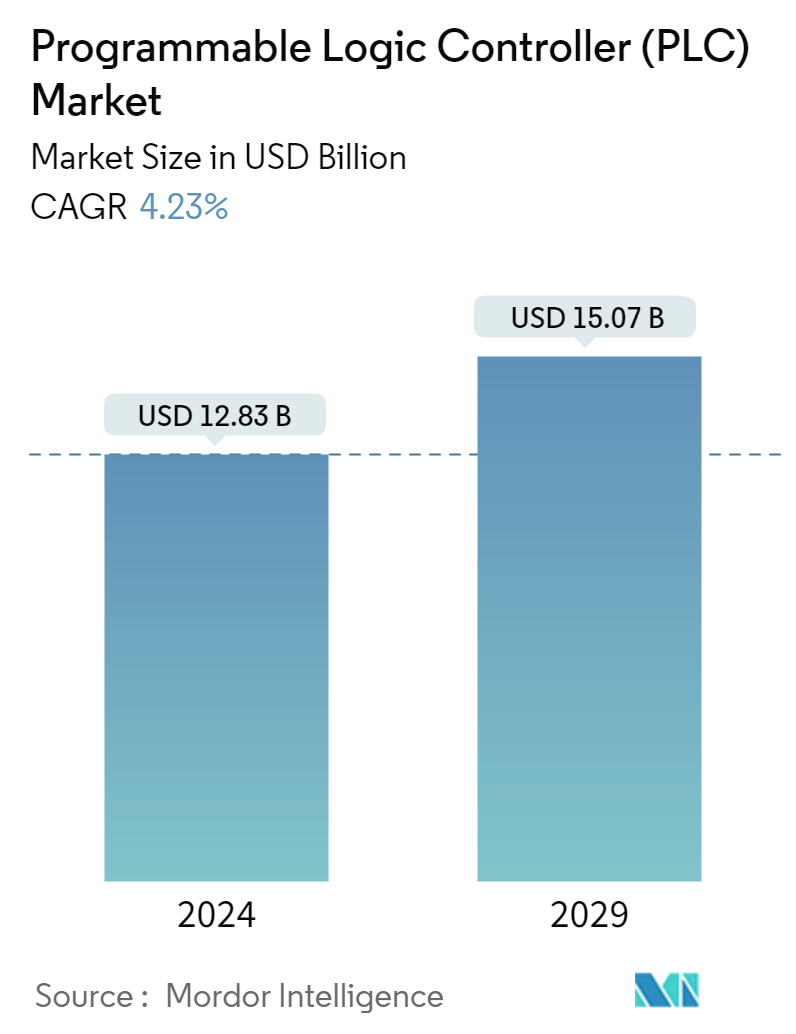
| Study Period | 2019 - 2029 |
| Market Size (2024) | USD 12.83 Billion |
| Market Size (2029) | USD 15.07 Billion |
| CAGR (2024 - 2029) | 4.23 % |
| Fastest Growing Market | Asia Pacific |
| Largest Market | Asia Pacific |
Major Players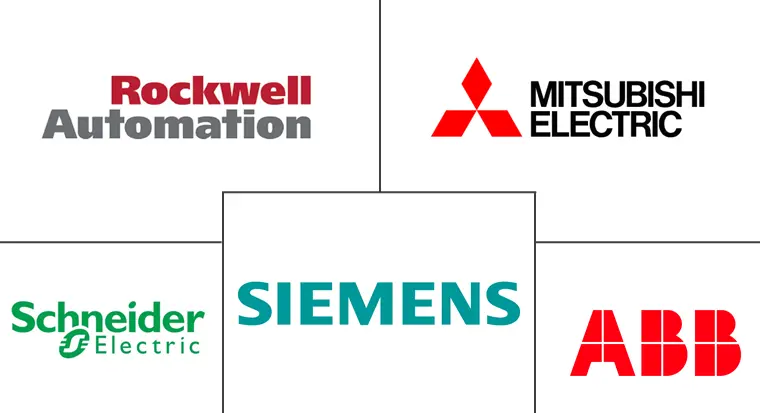
*Disclaimer: Major Players sorted in no particular order |
Need a report that reflects how COVID-19 has impacted this market and its growth?
Programmable Logic Controller (PLC) Market Analysis
The Programmable Logic Controller Market size is estimated at USD 12.83 billion in 2024, and is expected to reach USD 15.07 billion by 2029, growing at a CAGR of 4.23% during the forecast period (2024-2029).
- PLC is a significant computing system that manages automated machines. The system also assists in detecting errors or flaws and cautions the technician. Due to their packed sizes, PLC systems are desired over traditional ones, like relays and switch boxes. Another benefit of PLCs is their multi-functionality (due to their programmable nature, which can be utilized for multiple operations relying on the application).
- Machine downtime is a significant factor affecting an industry's manufacturing efficiency. Downtime is responsible for 5-20% of the manufacturing losses during operation. Installing PLC systems allows the identification and rectification of errors and can create quick reactions even without human intervention, thereby bringing efficiency into industrial processes.
- Industry automation is one of the significant factors driving the growth of the PLC market. Automation can be described as automatic processing systems that improve efficiency and decrease human intervention via the optimal usage of resources. The industries have now discovered the reliability and long-term profits that can be accomplished by utilizing automated systems. Conveyor systems & packaging systems, among others, can be automated using PLC systems. The growing penetration of automation in the industrial sector is also anticipated to favor the growth of the market.
- In addition, factory automation for greenfield projects, combined with rapidly rising activity throughout the process and discrete sectors in China, India, Indonesia, Brazil, Thailand, and the Middle East, has resulted in a massive demand for PLCs. Government initiatives such as China Manufacturing 2025 and Make in India have supported businesses in these regions.
- A significant trend impacting the market is the emphasis on innovative manufacturing practices. According to the data from IBEF, the Government of India set an ambitious target of increasing manufacturing output contribution to 25% of the GDP by 2025 from 16%. The Smart Advanced Manufacturing and Rapid Transformation Hub (SAMARTH) Udyog Bharat 4.0 initiative aims to improve awareness about Industry 4.0 within the Indian manufacturing industry and allow stakeholders to address challenges related to automation material handling.
- PLCs also help control manufacturing processes, like assembly lines, robotic devices, or any activity requiring high-reliability control and easy programming & operation fault diagnosis. PLCs are growing and remain the significant choice for different industrial automation applications. Scalability, greater memory, smaller sizes, high-speed (gigabit) Ethernet, & built-in wireless are among the emerging programmable logic controller capabilities.
- Due to modern consumers' need for personalized products, industries have driven themselves from a mass production model into mass customization. PLCs are broadly embraced in industries whose processes do not change. However, the growing end user need for customization of products has made the manufacturing processes more refined and complicated, with the need for frequent adjustments, consequently fueling the end users to adopt and invest in more flexible systems, like PC-based and cloud-based controllers, rather than PLCs, which is challenging the growth of the market.
- Macroeconomic factors, such as the general economic condition of a region and geopolitical issues, play a crucial role in the industrial sector's growth as these factors influence the investment and expansion capabilities of the industrial sector. For instance, the recent Russia-Ukraine war is impacting several countries on both economic and geopolitical stability verticals, which, in turn, is creating an unfavorable condition for the growth of the industrial sector. As PLCs are widely used in industries, such trends hamper the growth of the market.
Programmable Logic Controller (PLC) Market Trends
Automotive is Expected to Be the Fastest-growing End-user Industry
- PLCs are used at the manufacturing stage to handle the growing demands of the automotive industry. Initially, these were employed as relay replacement equipment in automotive manufacturing. PLCs let manufacturers work smarter & faster, and as automated processes reduce the occurrence of bottlenecks, this reduces expenses in operation and production time in the industry.
- Manufacturing plants of various automotive companies have been experiencing manufacturing changes to integrate new technology into the manufacturing stream to improve productivity and efficiency. For instance, ATS Applied Tech Systems Ltd developed a tracking and tracing system for airbags using InTrack, InTouch, and GE-Fanuc PLCs to gain full error-proofing and traceability. Using the system set-up, it is feasible to trace the airbag's origin and the production machines' status during manufacturing, in case a fault is detected, even up to 10 years after production.
- It has been identified that automation has significantly increased the efficiency of the auto assembly process. As a result, it shows a growing pattern in the number of cars being produced globally while simultaneously cutting costs, paving the way for smart factories' implementation in this sector. For many years, the automotive industry has used robots in the assembly lines for various manufacturing processes. Nowadays, automakers are exploring the use of robotics in more procedures. Robots are more flexible, efficient, accurate, and dependable for these product lines. This technology also enables the automotive industry to remain one of the most significant industrial adopters and possess one of the most automated supply chains.
- There has been an increasing demand for automobiles across the world. According to Scotiabank, worldwide automobile sales reached 75.3 million units in 2023 and are anticipated to reach 77 million units by the end of 2024.
- The growing proliferation of trends, such as electrification of connected and autonomous vehicles, is anticipated to significantly influence the growth of the market as these automobiles generally use a more significant number of electronic and control units wherein PLCs play a crucial role. Hence, the growing trends are anticipated to drive opportunities in the market during the forecast period. For instance, Hyundai Motor Group announced its plans to invest KRW 21 trillion through 2030 to expand its electric vehicle (EV) business in South Korea.
- In addition, the South Korean auto group, which houses Hyundai Motor Co and Kia Corp, plans to build 1.44 mn units of EVs in South Korea annually by 2030. As per the auto group, the 1.44 million EV production volume in South Korea would account for about 45% of a combined global EV production capacity of 3.23 million EV units in 2030.
- PLCs are designed to operate in noisy industrial environments with no extra filtering required. They are smaller, faster, and more reliable than hard-wired systems, which makes them ideal for automotive applications. Some researchers have been designing and implementing PLC-based closed-loop speed control for electric vehicle DC motors.
- For instance, researchers from the School of Mechanical Chemical and Materials Engineering and Adama Science and Technology University developed a basic PLC to control hybrid electric vehicle (HEV) power drive train control. The control program developed enables the two drive power sources (the motor and the IC engine) to work automatically. If the automated operation malfunctions, manually operating pushbuttons are designed to control the event. For the safety of the starter motor, the short period that the starter motor has to operate in cranking the IC engine was developed in the control program.
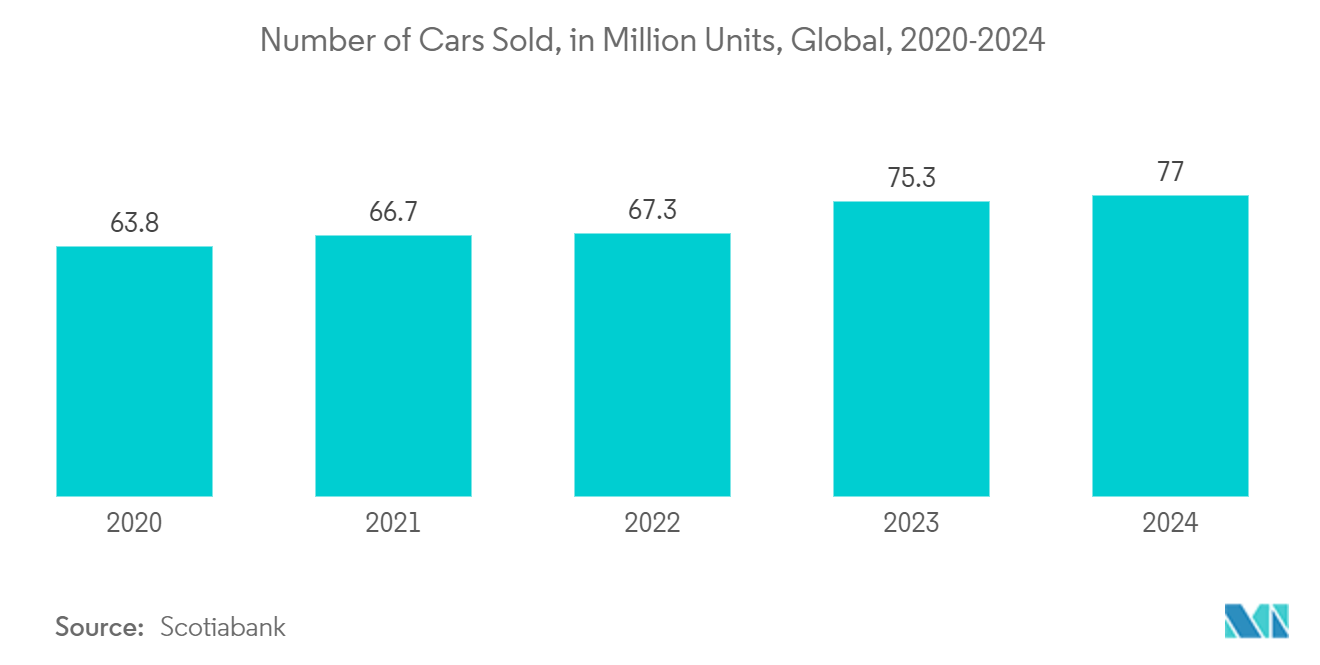
Asia-Pacific is Expected to Witness a Significant Market Growth
- Asia-Pacific has witnessed remarkable growth across various automotive, industrial, and manufacturing sectors in the last few decades. It is anticipated to continue its upward growth trajectory during the forecast period, creating opportunities in the studied market. For instance, the manufacturing sector constitutes a substantial part of China's economy, which is experiencing a fast transformation with the current growth in IoT due to the expansion of Industry 4.0 around the manufacturing industries worldwide. This large-scale conversion has put the country in one of the top positions in the PLC market.
- China's Ministry of Industry and Information Technology released its most recent five-year plan for robots. By 2025, the country expects the robotics industry's average annual operating income growth rate to exceed 20%. The five-year plan aims to broaden robotic uses to keep the country's robot population growing. Also, the Wuhan University Institute of Quality Development Strategy predicts that by 2025, machinery and robotics are set to replace nearly 5% of China's workforce. Such investments are expected to drive the PLC market during the forecast period.
- India is fueled by the increasing usage of robotic process automation (RPA) and artificial intelligence (AI)-based technologies. According to the global RPA forum Automation Anywhere, India is its second-biggest revenue generator behind the United States. Global capacity centers, service providers, and Indian enterprises are its most prominent customers.
- India's industrial automation sector has been transformed by the integration of digital and physical aspects of manufacturing to provide optimum performance. The emphasis on acquiring zero waste production and a faster time to reach the market has augmented the market's growth. For instance, in December 2023, Mitsubishi Electric announced the establishment of a new factory in India for Factory Automation Control System Products like PLCs. The new factory will manufacture factory automation (FA) control system products like programmable logic controllers (PLCs).
- Moreover, Japan has the most significant market share in the robot manufacturing industry and installed methods where industrial robots are used to assemble robots. According to the Japan Statistics Bureau, the revenue from robots in Japan is anticipated to amount to approximately USD 16.35 billion by 2024.
- The Government of Japan has announced that by 2035, all new passenger cars sold domestically should be electrified, creating expectations for the growth of electric vehicles in Japan. Japan has also vowed to become carbon neutral by 2050, so electric cars have become more of a necessity for the country to meet these targets. As the number of internet users is increasing at a fast pace in Japan, the usage of internet connectivity has reproduced the possibilities, especially when it comes to PLC.
- Increasing food and beverage industry investments are expected to drive the market's growth. For instance, research conducted by Rabobank (a Dutch multinational banking and financial services company) and Temasek (a Singapore state investor) indicated that over the next 10 years (by 2030), an investment of USD 800 billion is required for the food and agriculture industry in Asia, to meet the region's growing food demand. Such investments in the food and beverage industry have fueled the growth of PLCs in the domain.
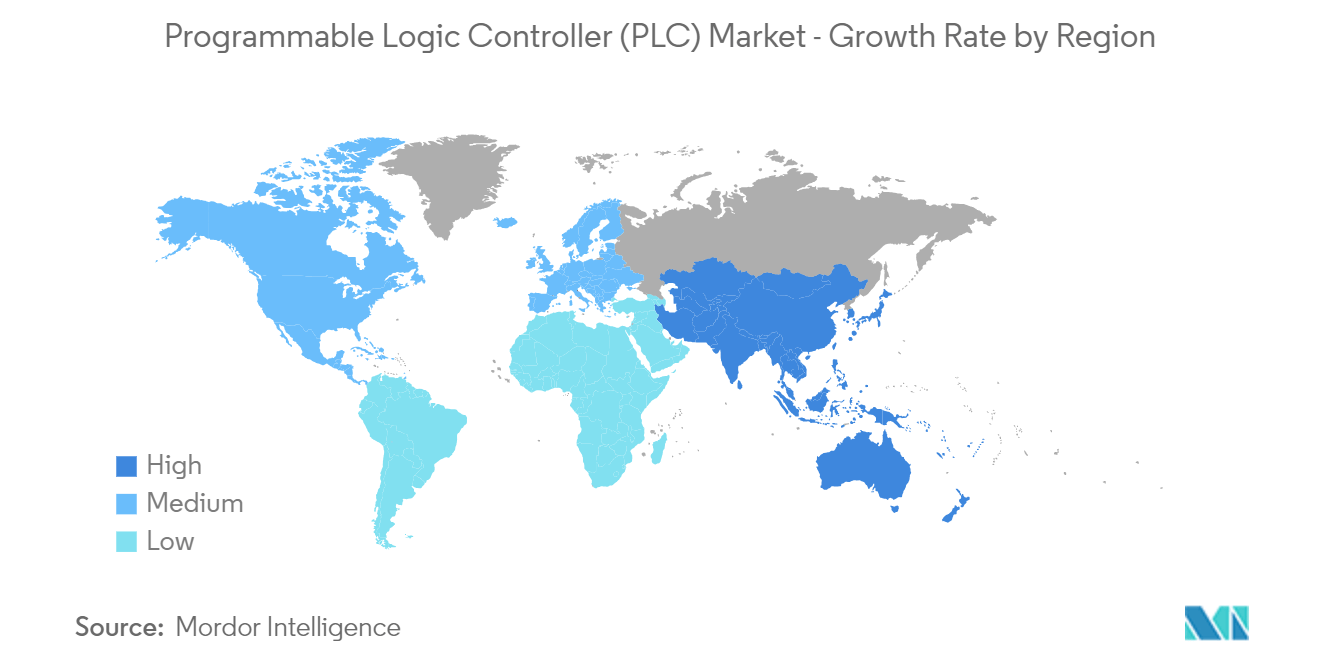
Programmable Logic Controller (PLC) Industry Overview
The programmable logic controller (PLC) market is moderately fragmented, with major players such as ABB Ltd, Mitsubishi Electric Corporation, Schneider Electric SE, Rockwell Automation Inc., and Siemens AG. Players in the market are adopting strategies like partnerships, mergers, and acquisitions to enhance their product offerings and gain sustainable competitive advantage.
- December 2023: Mitsubishi Electric launched a new IIoT-ready high-performance PLC. The latest MELSEC FX5S PLC is designed to support businesses on their digital transformation journey, offering a cost-effective, easy-to-use control solution. The newest addition to the MELSEC iQ-F series of compact, high-performance PLCs is ideal for simple, straightforward food, beverage, water, and machining applications. It offers Industrial Internet of Things (IIoT) functions for practical, entry-level industrial automation applications.
- July 2023: Siemens launched a complete virtual programmable logic controller. The Simatic S7-1500V expands the company's existing Simatic portfolio to special market requirements, including virtual hosting of PLC computing. According to the company, Simatic S7-1500V is part of Industrial Operations X, which consistently focuses on integrating IT and software capabilities into the automation landscape.
Programmable Logic Controller (PLC) Market Leaders
ABB Ltd.
Mitsubishi Electric Corporation
Schneider Electric SE
Rockwell Automation, Inc.
Siemens AG
*Disclaimer: Major Players sorted in no particular order
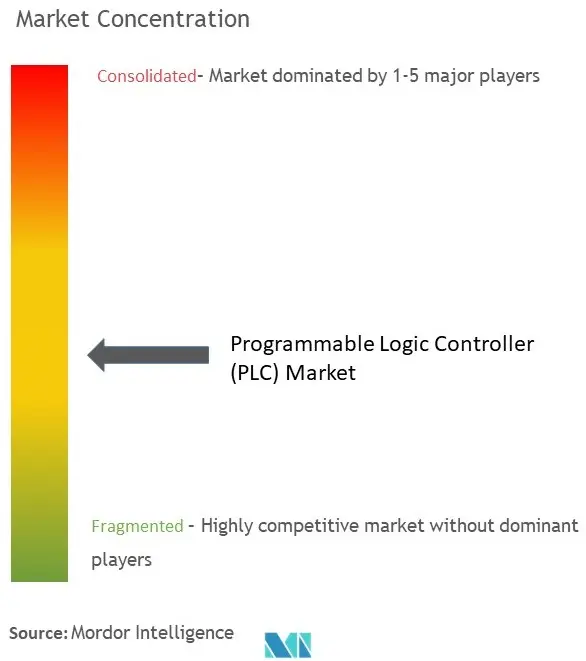
Programmable Logic Controller (PLC) Market News
- March 2024: Global automation player FANUC America Corporation announced its latest combined PLC/CNC motion controller, Power Motion i-MODEL A Plus (PMi-A Plus), at MODEX 2024 in Atlanta, GA, booth B-4026. The new demo at MODEX will show the PMi-A Plus controlling FANUC’s new Alpha i-D Series Servos and Drives to power an automatic storage retrieval system (ASRS) tended by a FANUC CRX-10iA.
- February 2024: WEG launched the PLC410 programmable logic controller to the market. This unique controller is a versatile solution in industrial automation that can be applied in various industrial sectors, including metallurgy, pharmaceuticals, pulp and paper, sugar, and alcohol. The PLC410 will become the brains of automation in customers' machines and equipment. With it, developers can create advanced process programming logic using CODESYS programming software.
PLC Market Report - Table of Contents
1. INTRODUCTION
1.1 Study Assumptions and Market Definition
1.2 Scope of the Study
2. RESEARCH METHODOLOGY
3. EXECUTIVE SUMMARY
4. MARKET INSIGHTS
4.1 Market Overview
4.2 Industry Attractiveness - Porter's Five Forces Analysis
4.2.1 Bargaining Power of Suppliers
4.2.2 Bargaining Power of Buyers
4.2.3 Threat of New Entrants
4.2.4 Threat of Substitutes
4.2.5 Intensity of Competitive Rivalry
4.3 Impact of Macroeconomic Trends on the Market
5. MARKET DYNAMICS
5.1 Market Drivers
5.1.1 Increased Adoption of Automation Systems
5.1.2 Ease of Use and Familiarity with PLC Programming to Sustain Growth
5.2 Market Restraints
5.2.1 Demand for Customization of Products and Gradual Shift from Batch to Continuous Processing in the Discrete Industries
5.2.2 Increase in Adoption of Distributed Control Systems (DCS), with Enhanced Safety and Advanced Control Capabilities
6. MARKET SEGMENTATION
6.1 By Type
6.1.1 Hardware and Software
6.1.1.1 Large PLC
6.1.1.2 Nano PLC
6.1.1.3 Small PLC
6.1.1.4 Medium PLC
6.1.1.5 Other Types
6.1.2 Services
6.2 By End-user Industry
6.2.1 Food, Tobacco, and Beverage
6.2.2 Automotive
6.2.3 Chemical and Petrochemical
6.2.4 Energy and Utilities
6.2.5 Pulp and Paper
6.2.6 Oil and Gas
6.2.7 Water and Wastewater Treatment
6.2.8 Pharmaceutical
6.2.9 Other End-user Industries
6.3 By Geography
6.3.1 North America
6.3.1.1 United States
6.3.1.2 Canada
6.3.2 Europe
6.3.2.1 United Kingdom
6.3.2.2 Germany
6.3.2.3 France
6.3.2.4 Rest of Europe
6.3.3 Asia-Pacific
6.3.3.1 China
6.3.3.2 India
6.3.3.3 Japan
6.3.3.4 Rest of Asia-Pacific
6.3.4 Latin America
6.3.5 Middle East and Africa
7. COMPETITIVE LANDSCAPE
7.1 Company Profiles
7.1.1 ABB Ltd
7.1.2 Mitsubishi Electric Corporation
7.1.3 Schneider Electric SE
7.1.4 Rockwell Automation Inc.
7.1.5 Siemens AG
7.1.6 Honeywell International Inc.
7.1.7 Omron Corporation
7.1.8 Panasonic Corporation
7.1.9 Robert Bosch GmbH
7.1.10 Emerson Electric Co.
7.1.11 Hitachi Ltd
7.1.12 Toshiba International Corporation
- *List Not Exhaustive
8. INVESTMENT ANALYSIS
9. FUTURE OF THE MARKET
Programmable Logic Controller (PLC) Industry Segmentation
PLC is the primary computing system that controls automated machines. The system also helps detect errors or flaws and alerts the technician. Due to their compact sizes, PLC systems are preferred over traditional ones, like relays and switch boxes. Another advantage of PLCs is their multi-functionality (owing to their programmable nature, which can be used for multiple operations depending on the application. The PLC consists of hardware, software, and services. The basic architecture of the PLC consists of the main components: the processor module, the power supply, and the I/O modules.
The programmable logic controller (PLC) market is segmented by type (hardware and software {large PLC, nano PLC, small PLC, medium PLC, and other types], services}, end-user industry (food, tobacco and beverage, automotive, chemical and petrochemical, energy and utilities, pulp and paper, oil and gas, water and wastewater treatment, pharmaceutical, and other end-user industries), and geography (North America {United States and Canada}, Europe {United Kingdom, Germany, France, and Rest of Europe}, Asia-Pacific {China, India, Japan, and Rest of Asia-Pacific}, Latin America, and Middle East and Africa). The market sizes and forecasts are provided in terms of value in USD for all the above segments.
| By Type | |||||||
| |||||||
| Services |
| By End-user Industry | |
| Food, Tobacco, and Beverage | |
| Automotive | |
| Chemical and Petrochemical | |
| Energy and Utilities | |
| Pulp and Paper | |
| Oil and Gas | |
| Water and Wastewater Treatment | |
| Pharmaceutical | |
| Other End-user Industries |
| By Geography | ||||||
| ||||||
| ||||||
| ||||||
| Latin America | ||||||
| Middle East and Africa |
PLC Market Research FAQs
How big is the Programmable Logic Controller Market?
The Programmable Logic Controller Market size is expected to reach USD 12.83 billion in 2024 and grow at a CAGR of 4.23% to reach USD 15.07 billion by 2029.
What is the current Programmable Logic Controller Market size?
In 2024, the Programmable Logic Controller Market size is expected to reach USD 12.83 billion.
Who are the key players in Programmable Logic Controller Market?
ABB Ltd., Mitsubishi Electric Corporation, Schneider Electric SE, Rockwell Automation, Inc. and Siemens AG are the major companies operating in the Programmable Logic Controller Market.
Which is the fastest growing region in Programmable Logic Controller Market?
Asia Pacific is estimated to grow at the highest CAGR over the forecast period (2024-2029).
Which region has the biggest share in Programmable Logic Controller Market?
In 2024, the Asia Pacific accounts for the largest market share in Programmable Logic Controller Market.
What years does this Programmable Logic Controller Market cover, and what was the market size in 2023?
In 2023, the Programmable Logic Controller Market size was estimated at USD 12.29 billion. The report covers the Programmable Logic Controller Market historical market size for years: 2019, 2020, 2021, 2022 and 2023. The report also forecasts the Programmable Logic Controller Market size for years: 2024, 2025, 2026, 2027, 2028 and 2029.
PLC Industry Report
Statistics for the 2024 Programmable Logic Controller (PLC) market share, size and revenue growth rate, created by Mordor Intelligence™ Industry Reports. Programmable Logic Controller (PLC) analysis includes a market forecast outlook to for 2024 to 2029 and historical overview. Get a sample of this industry analysis as a free report PDF download.
